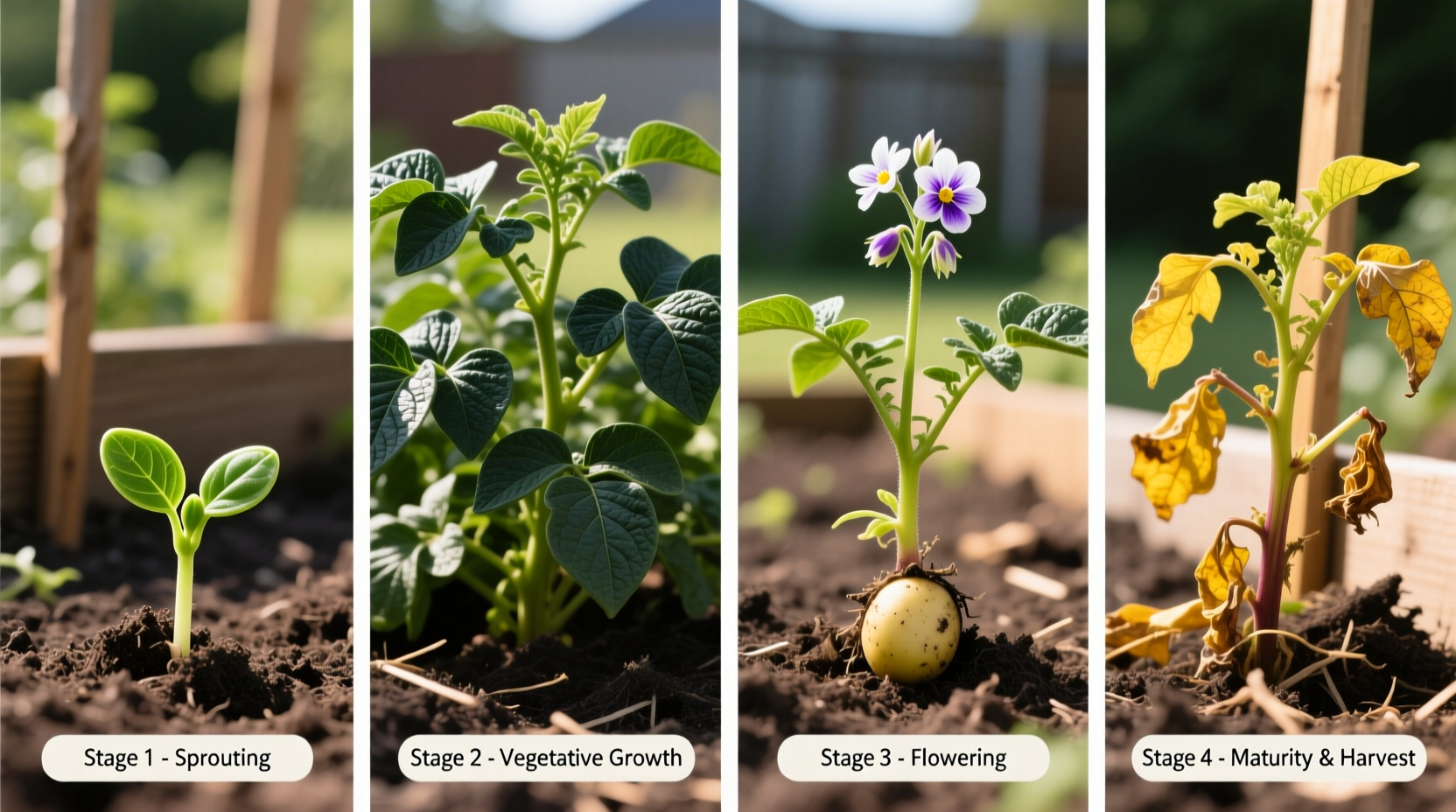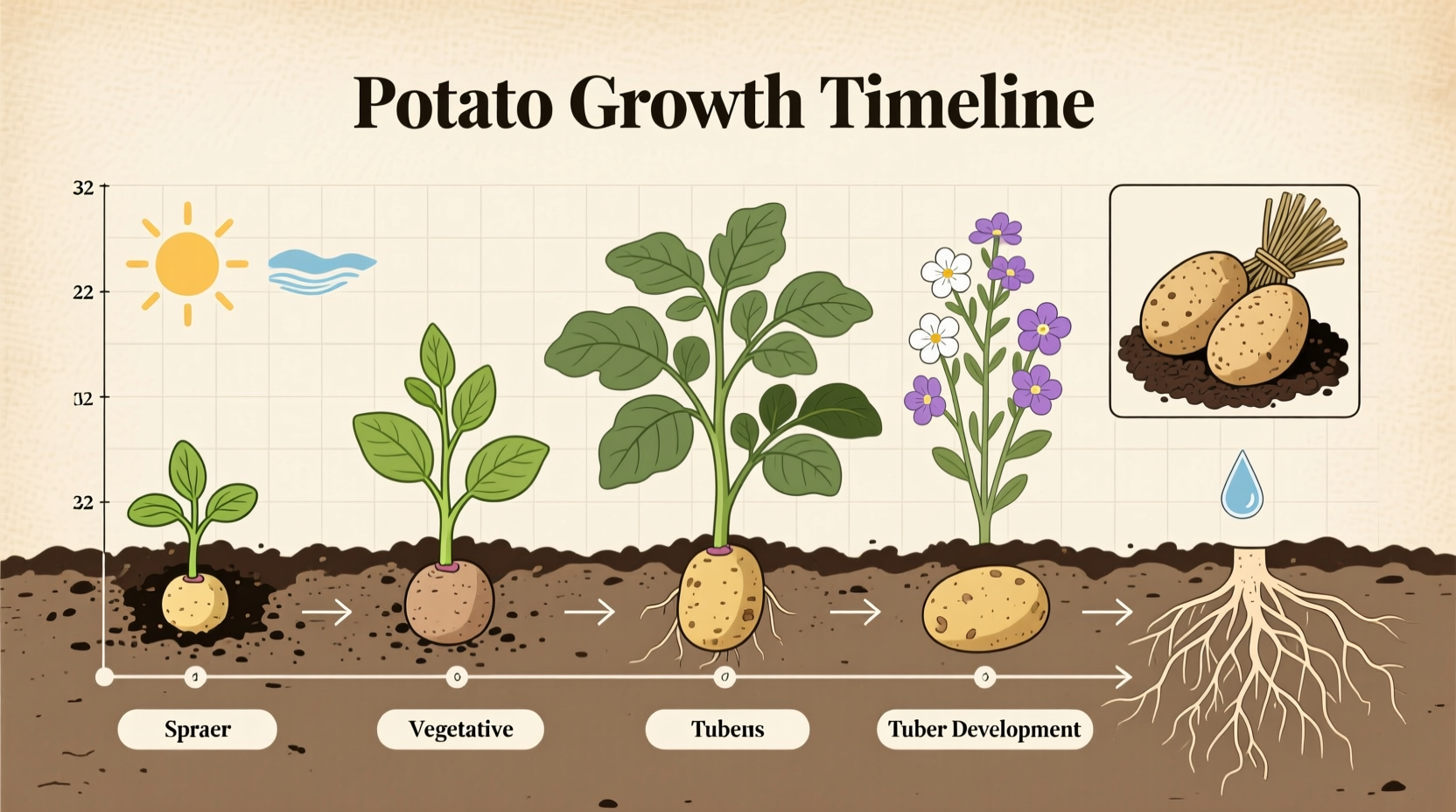Most potato varieties take 70-120 days from planting to harvest, depending on the type and growing conditions. Early varieties mature in 70-90 days, mid-season varieties in 90-110 days, and late varieties require 110-120+ days to reach full maturity.
Whether you're planning your first garden or optimizing your potato patch, understanding the precise timeline for potato growth is essential for a successful harvest. This comprehensive guide breaks down exactly how long it takes to grow potatoes at each stage, with practical tips to maximize your yield based on your specific climate and variety.
Understanding Potato Growth Stages and Timelines
Potatoes progress through several distinct growth phases, each with its own timeline. Knowing these stages helps you monitor plant health and determine the optimal harvest time.
| Growth Stage | Duration | Key Characteristics |
|---|---|---|
| Germination & Sprouting | 14-30 days | "Eyes" sprout, shoots emerge from soil |
| Vegetative Growth | 30-50 days | Stem and leaf development, photosynthesis begins |
| Tuber Initiation | 5-10 days | Stolons develop into tubers, critical temperature window |
| Tuber Bulking | 30-60 days | Rapid tuber expansion, most critical growth phase |
| Maturity | 10-20 days | Vine yellowing, skin hardening, optimal harvest time |
This growth timeline comes from research conducted by the USDA Agricultural Research Service, which has documented potato development across multiple growing seasons and climate zones. The tuber bulking phase represents the most variable stage, where environmental conditions significantly impact final yield and maturity timing.
How Potato Varieties Affect Growing Time
Not all potatoes grow at the same pace. The variety you select dramatically impacts your harvest timeline:
- Early varieties (70-90 days): Fingerling, Norland, Irish Cobbler - best for new potatoes
- Mid-season varieties (90-110 days): Yukon Gold, Kennebec, Red Pontiac - balance of storage and flavor
- Late varieties (110-120+ days): Russet Burbank, Katahdin, Purple Majesty - superior for long-term storage
According to Cornell University Cooperative Extension, early varieties develop more quickly but generally have thinner skins and don't store as well as late-season potatoes. If you're growing potatoes primarily for immediate consumption rather than storage, early varieties provide the fastest return on your gardening investment.
Environmental Factors That Impact Potato Growth Time
Your local conditions significantly influence how long it takes to grow potatoes to maturity. Understanding these variables helps you adjust expectations and optimize your growing approach.
Climate Considerations
Potatoes thrive in cool temperatures (60-70°F / 15-21°C) during tuber formation. When temperatures exceed 80°F (27°C), tuber development slows dramatically or stops completely. This explains why gardeners in warmer climates often plant potatoes as a winter crop, while northern gardeners plant in early spring.
The University of California Agriculture and Natural Resources notes that in regions with short growing seasons, selecting early-maturing varieties and using season-extending techniques like mulching can help ensure a successful harvest before summer heat arrives.
Soil Conditions and Preparation
Well-drained, loose soil with consistent moisture accelerates potato growth. Heavy clay soils slow development, while sandy soils may require more frequent watering. The ideal soil pH for potatoes ranges from 5.0 to 6.0.
Proper soil preparation before planting—including adding organic matter and ensuring proper drainage—can reduce your overall growing time by 7-10 days compared to unamended soil, according to agricultural studies from land-grant universities.
Practical Tips to Optimize Your Potato Growing Timeline
While you can't change your climate, several techniques can help you grow potatoes more efficiently:
- Chitting (pre-sprouting): Allow seed potatoes to sprout indoors 2-4 weeks before planting, giving them a 10-14 day head start
- Proper hilling technique: Hill soil around plants when they reach 6-8 inches tall, then repeat every 2-3 weeks to encourage more tuber formation
- Consistent watering: Maintain even soil moisture (1-2 inches per week), especially during tuber initiation and bulking phases
- Temperature management: Use straw mulch to keep soil cooler in warm climates or row covers to extend the season in cooler regions

When to Harvest Your Potatoes
Timing your harvest correctly ensures the best flavor and storage potential:
- New potatoes: Harvest 2-3 weeks after plants flower (about 7-8 weeks for early varieties)
- Maincrop potatoes: Wait until vines naturally yellow and die back (typically 2-3 weeks after flowering)
- Storage potatoes: Allow skins to harden for 2-3 weeks after vine death before harvesting
Harvesting too early yields smaller potatoes with thin skins that don't store well. Waiting too long risks tuber damage from soil moisture or pests. The optimal harvest window varies by variety and local conditions, but generally falls within the 70-120 day range after planting.
Troubleshooting Common Growth Delays
If your potatoes seem to be taking longer than expected to mature, consider these common issues:
- Nitrogen imbalance: Too much nitrogen promotes leaf growth at the expense of tubers
- Inconsistent watering: Fluctuating moisture causes irregular tuber development
- Pest pressure: Colorado potato beetles or wireworms damage plants and slow growth
- Temperature stress: Extended periods above 80°F halt tuber formation
Addressing these issues promptly can get your potato growth back on track and prevent significant delays in your harvest timeline.
Planning Your Potato Growing Schedule
For successful potato cultivation, work backward from your desired harvest date:
- Determine your first fall frost date (for fall harvest) or last spring frost date (for summer harvest)
- Count backward the days to maturity for your chosen variety (plus 10-14 days for harvest window)
- Add 14 days for germination time
- Adjust for your local climate conditions (add time in cooler regions, subtract in warmer ones)
This backward planning approach ensures you plant at the optimal time for your specific location and variety, maximizing your chances of a successful harvest within the expected timeframe.











 浙公网安备
33010002000092号
浙公网安备
33010002000092号 浙B2-20120091-4
浙B2-20120091-4